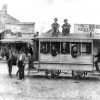calsfoundation@cals.org
Eagle [Steamboat]
The Eagle was a 118-ton steamboat that was the first steamer to navigate up the Arkansas River to Little Rock (Pulaski County), stopping at the capital on its way to deliver supplies to Dwight Mission near modern-day Russellville (Pope County).
The Eagle, which was built in 1818 and commanded by a Captain Morris, reached Little Rock on March 16, 1822, having left New Orleans, Louisiana, seventeen days earlier and taken fifty-one hours to reach the territorial capital from the mouth of the Arkansas River—a journey that would have taken up to a month by keelboat. The Arkansas Gazette reported that Little Rock’s citizens were “very agreeably surprised” by the vessel’s arrival, which “reflects much credit on Capt. Morris for his enterprize [sic].” The newspaper held that “the arrival of the Eagle opens a new and interesting era in the navigation and commerce of the Arkansas—and, judging from the increasing industry of our citizens, and the efforts at present making for raising cotton, and the other staple commodities of our country, it needs no inspiration to predict, that the time is not far distant, when steam-boats will be no less a novelty on this noble river, than they are at this time on other principal tributaries of the Mississippi.”
The Eagle continued up the Arkansas, carrying Governor James Miller as a passenger, to within twelve miles of Dwight Mission, where low water forced them to offload their cargo. The steamboat returned to Little Rock on March 19, and the Gazette reported that “we understand, that she will hereafter ascend the Arkansas as often as the water will permit, and sufficient business can be found for her employment.” The vessel is next mentioned in the May 20, 1823, Gazette, where the Eagle, now commanded by a Captain Wood, “arrived…in 10 days from New Orleans, with full freight, for F. Notrebe, Eli J. Lewis, and Scull & Bogy.”
There is no mention in the newspaper of a steamboat Eagle for the next eleven years, until the Gazette on September 23, 1834, reported that the steamboat—which may or may not be the same one that reached Little Rock in 1822—had been stranded near Pine Bluff (Jefferson County) for two weeks waiting for a rise in the Arkansas River. On October 14, 1834, the Gazette noted that the Eagle had returned to Little Rock after failing to ply the river beyond the mouth of Cadron Creek because of low water “and left on Saturday, for the Mouth of White River, from whence she will immediately return.” The final reference to the Eagle in the Gazette came on September 8, 1835, when the newspaper reported that the vessel’s proprietor planned regular runs between Little Rock and the mouths of the White and Arkansas rivers. The vessel’s ultimate fate is unknown.
For additional information:
Arkansas Gazette, May 20, 1823, p. 3; September 23, 1834, p. 3; October 14, 1834, p. 3; September 8, 1835, p. 2.
“Arrival of the Steam-Boat Eagle.” Arkansas Gazette Weekly, March 19, 1822, p. 3.
Hunter, Louis C. Steamboats on Western Rivers: An Economic and Technological History. Cambridge: Harvard University Press, 1949.
Roy, F. Hampton, Sr., and Charles Witsell Jr., with Cheryl Griffith Nichols. How We Lived: Little Rock as an American City. Little Rock: August House, 1984.
Mark K. Christ
Little Rock, Arkansas






Comments
No comments on this entry yet.